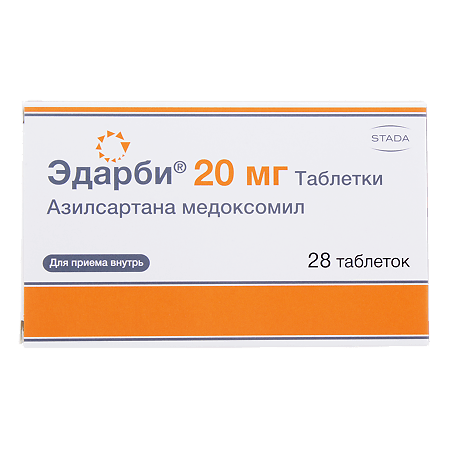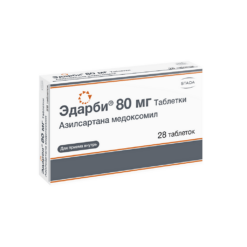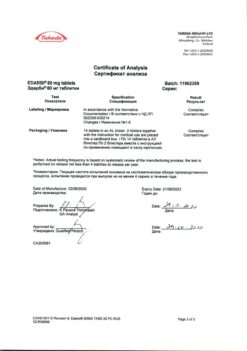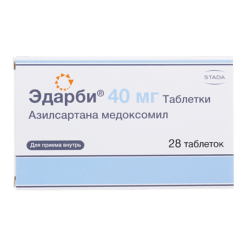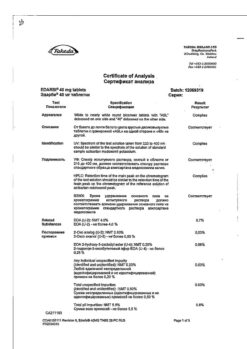No products in the cart.
Edarbi, tablets 20 mg 28 pcs
€15.85 €13.73
Description
A specific angiotensin II type 1 receptor antagonist (AT1). Azilsartan medoxomil is a prodrug. It rapidly converts to the active molecule azilsartan, which selectively inhibits the effects of angiotensin II by blocking its binding to AT1 receptors in various tissues. Angiotensin II is the primary vasoactive hormone of the RAAS with effects including vasoconstriction, cardiac stimulation, stimulation of aldosterone synthesis and release, and consequent renal sodium reabsorption.
At1 receptor blockade inhibits the negative regulatory response of angiotensin II to renin secretion, but the resulting increase in plasma renin activity and circulating angiotensin II levels does not suppress the antihypertensive effect of azilsartan.
The antihypertensive effect of azilsartan medoxomil develops during the first 2 weeks of use with reaching maximum therapeutic effect after 4 weeks. Decrease in BP after a single oral dose is usually achieved within several hours and maintained for 24 hours.
No withdrawal syndrome has been observed after abrupt discontinuation of long-term therapy (over 6 months) with Edarbi®.
The safety and efficacy of the drug are not dependent on the age of patients, but greater sensitivity to BP reduction in some elderly patients cannot be excluded.
As with other angiotensin II receptor antagonists and ACE inhibitors, the antihypertensive effect is less pronounced in patients of non-Hispanic race (usually a population with low plasma renin activity). Concomitant use of Edarbi® 40 mg and 80 mg with dihydropyridine slow calcium channel blockers (amlodipine) or thiazide diuretics (chlorthalidone) leads to additional BP reduction compared to therapy with antihypertensive agents used in monotherapy.
The effect on repolarization processes
The evaluation of the potential of Edarbi® to prolong the QT/QTc interval was performed in healthy volunteers during the QT/QTc study. No increase in the QT/QTc interval was observed with the use of Edarbi® at a dose of 320 mg. QTc is the corrected (relative to HR) value of the QT interval, a relative value. Because the QT interval duration depends on heart rate (lengthening as it slows down), it must be corrected relative to HR to estimate it.
Lengthening of the QT interval reflects heterogeneity of ventricular myocardial repolarization processes and is considered as an independent indicator indicating the possibility of fatal heart rhythm disturbances.
Indications
Indications
essential hypertension.
Pharmacological effect
Pharmacological effect
Specific antagonist of angiotensin II type 1 receptors (AT1). Azilsartan medoxomil is a prodrug. It is quickly converted into the active azilsartan molecule, which selectively prevents the development of the effects of angiotensin II by blocking its binding to AT1 receptors in various tissues. Angiotensin II is the primary vasoactive hormone of the RAAS with effects including vasoconstriction, cardiac stimulation, stimulation of aldosterone synthesis and release, and consequent renal sodium reabsorption.
Blockade of AT1 receptors inhibits the negative regulatory response of angiotensin II to renin secretion, but the resulting increase in plasma renin activity and circulating angiotensin II levels does not suppress the antihypertensive effect of azilsartan.
The antihypertensive effect of azilsartan medoxomil develops during the first 2 weeks of use with the maximum therapeutic effect achieved after 4 weeks. A reduction in blood pressure after oral administration of a single dose is usually achieved within a few hours and persists for 24 hours.
Withdrawal syndrome after sudden cessation of treatment with long-term therapy (for 6 months) with Edarbi® was not observed.
The safety and effectiveness of the drug do not depend on the age of the patients, but greater sensitivity to lowering blood pressure in some elderly patients cannot be excluded.
As with other angiotensin II receptor antagonists and ACE inhibitors, the antihypertensive effect is less pronounced in black patients (usually a population with low plasma renin activity). The simultaneous use of Edarbi® 40 mg and 80 mg with dihydropyridine blockers of slow calcium channels (amlodipine) or thiazide diuretics (chlorthalidone) leads to an additional reduction in blood pressure compared to therapy with antihypertensive drugs used in monotherapy.
Influence on repolarization processes
The potential of Edarbi® to prolong the QT/QTc interval was assessed in healthy volunteers during a QT/QTc study. When using the drug Edarbi® at a dose of 320 mg, no increase in the QT/QTc interval was noted. QTc – corrected (relative to heart rate) value of the QT interval, relative value. Because The duration of the QT interval depends on the heart rate (lengthening as it slows down); to assess it, it must be corrected for heart rate.
Prolongation of the QT interval reflects the heterogeneity of the processes of repolarization of the ventricular myocardium, and is regarded as an independent indicator indicating the possibility of fatal cardiac arrhythmias.
Special instructions
Special instructions
In patients whose vascular tone and renal function depend to a large extent on the activity of the RAAS (for example, in patients with severe chronic heart failure (NYHA functional class IV), severe renal failure or renal artery stenosis), treatment with drugs acting on the RAAS, such as ACE inhibitors and angiotensin II receptor antagonists, is associated with the possibility of developing acute arterial hypotension, azotemia, oliguria or, rarely, acute renal failure. The possibility of developing the listed effects cannot be excluded when using Edarbi®.
A sharp decrease in blood pressure in patients with ischemic cardiomyopathy or ischemic cerebrovascular diseases can lead to the development of myocardial infarction or stroke.
There are no data on the use of Edarbi® in patients who have recently undergone kidney transplantation.
There are no data on clinical experience with the use of Edarbi® in patients with severe liver dysfunction, therefore the use of the drug in this category of patients is not recommended.
In patients with reduced blood volume and/or hyponatremia (as a result of vomiting, diarrhea, taking high doses of diuretics, or following a diet with limited sodium intake), clinically significant arterial hypotension may develop after initiation of therapy with Edarbi®. Hypovolemia should be corrected before starting treatment with Edarbi® or starting treatment with a dosage of 20 mg.
Patients with primary hyperaldosteronism are usually resistant to treatment with antihypertensive drugs that affect the RAAS. In this regard, Edarbi® is not recommended for use in such patients.
Clinical experience with other drugs that affect the RAAS shows that simultaneous administration of Edarbi® with potassium-sparing diuretics, potassium supplements or salt substitutes containing potassium, or other drugs that can increase the level of potassium in the blood (for example, heparin) can lead to hyperkalemia in patients with arterial hypertension. Elderly patients, patients with renal failure, diabetes mellitus and/or patients with other concomitant diseases increase the risk of developing hyperkalemia, which can be fatal. In such patients, it is recommended to monitor serum potassium levels.
When using Edarbi® in patients with aortic or mitral stenosis or hypertrophic obstructive cardiomyopathy, caution must be exercised.
As with the use of other angiotensin II receptor antagonists, simultaneous use of lithium and Edarbi® is not recommended.
Impact on the ability to drive vehicles and operate machinery
Based on the pharmacodynamic properties, it is expected that azilsartan medoxomil will have a slight effect on the ability to drive vehicles and operate machinery. Caution must be exercised, as with any antihypertensive drugs (risk of dizziness and fatigue).
Active ingredient
Active ingredient
Azilsartan medoxomil
Composition
Composition
Composition of 1 tablet:
Contraindications
Contraindications
severe liver dysfunction (more than 9 points on the Child-Pugh scale) (no experience with use);
pregnancy;
simultaneous use of aliskiren in patients with diabetes mellitus;
age under 18 years (efficacy and safety have not been established);
hypersensitivity to the active substance and other components of the drug.
The drug should be used with caution in severe chronic heart failure (functional class IV according to the NYHA classification); severe renal failure (creatinine clearance <30 ml/min); bilateral renal artery stenosis and stenosis of the artery of the only functioning kidney; ischemic cardiomyopathy; ischemic cerebrovascular diseases; condition after kidney transplantation; conditions accompanied by a decrease in blood volume (including vomiting, diarrhea), as well as in patients on a diet with limited salt; when used simultaneously with diuretics in high doses; primary hyperaldosteronism; hyperkalemia; stenosis of the aortic and mitral valves; hypertrophic obstructive cardiomyopathy (HOCM); in patients over 75 years of age.
Side Effects
Side Effects
The frequency of adverse reactions was determined in accordance with WHO recommendations: very often (>1/10); often (>1/100, 1/1000, 1/10,000, <1/1000); very rare (<1/10,000), including isolated reports; unspecified frequency (frequency cannot be calculated from available data).
From the nervous system: often – dizziness.
From the cardiovascular system: infrequently – a pronounced decrease in blood pressure.
From the digestive system: often – diarrhea; infrequently – nausea.
From the skin and subcutaneous tissues: infrequently – rash, itching; rarely – angioedema.
From the musculoskeletal system: infrequently – muscle spasms.
From laboratory and instrumental studies: often – increased CPK activity; infrequently – increased creatinine concentration, hyperuricemia.
Other: infrequently – increased fatigue, peripheral edema.
Description of selected adverse reactions
With simultaneous use of the drug Edarbi® with chlorthalidone, the frequency of adverse reactions – a pronounced decrease in blood pressure and an increase in creatinine concentration – increases in frequency from “infrequently” to “often”.
With simultaneous use of Edarbi® with amlodipine, the frequency of an undesirable reaction – peripheral edema – increases from infrequent to frequent, but is less common than with amlodipine monotherapy.
Angioedema, including swelling of the face, lips and periorbital edema, is rare.
As with the use of other angiotensin II receptor antagonists and ACE inhibitors, the simultaneous use of Edarbi® with diuretics (for example, chlorthalidone) leads to an increased incidence of increased creatinine concentrations. An increase in creatinine concentration with simultaneous use of Edarbi® with diuretics is associated with a more pronounced decrease in blood pressure compared to monotherapy with Edarbi®. Most of these effects were short-lived or did not progress as long as patients continued therapy. After discontinuation of the drug, most cases of increase in creatinine concentration that did not go away during treatment were reversible. Creatinine concentrations returned to baseline values or values close to baseline in most patients.
When treated with Edarbi®, a slight increase in the concentration of uric acid in the blood serum (10.8 µmol/l) was observed compared to placebo (4.3 µmol/l).
As with the use of other RAAS inhibitors, when using Edarbi® as monotherapy, a slight decrease in hemoglobin and hematocrit was observed (on average, they decreased by about 3 g/l and 1 vol.%, respectively).
If any of the side effects indicated in the instructions get worse, or the patient notices other side effects not listed in the instructions, you should inform your doctor.
Interaction
Interaction
A reversible increase in serum lithium concentrations and toxicity were observed with simultaneous use of lithium preparations and ACE inhibitors and lithium preparations with angiotensin II receptor antagonists. Therefore, the simultaneous use of azilsartan medoxomil in combination with lithium preparations is not recommended. If it is necessary to use this combination, regular monitoring of lithium levels in the blood serum is recommended.
With the simultaneous use of angiotensin II antagonists and NSAIDs (for example, selective COX-2 inhibitors, acetylsalicylic acid (more than 3 g / day) and non-selective NSAIDs), the antihypertensive effect may be weakened. With simultaneous use of angiotensin II antagonists and NSAIDs, the risk of renal dysfunction and an increase in serum potassium may increase. Therefore, at the beginning of treatment, patients are advised to regularly take sufficient fluids and monitor kidney function.
Concomitant use of potassium-sparing diuretics, potassium supplements, salt substitutes containing potassium and other drugs (for example, heparin) with azilsartan medoxomil may lead to an increase in serum potassium levels. Patients should monitor serum potassium levels during combination therapy.
Dual blockade of the RAAS with angiotensin II receptor antagonists, ACE inhibitors, or aliskiren is associated with an increased risk of hypotension, hyperkalemia, and renal dysfunction (including acute renal failure) compared with monotherapy.
No pharmacokinetic interactions were observed with simultaneous use of azilsartan medoxomil or azilsartan with amlodipine, antacids (magnesium and aluminum hydroxide), chlorthalidone, digoxin, fluconazole, glibenclamide, ketoconazole, metformin and warfarin.
Azilsartan medoxomil is converted into the pharmacologically active metabolite azilsartan during absorption from the gastrointestinal tract under the action of the enzyme carboxymethylenebutenolidase in the intestines and liver. In vitro studies have shown that interactions based on enzyme inhibition are unlikely.
The antihypertensive effect of azilsartan medoxomil therapy can be enhanced when used in combination with other antihypertensive agents, including diuretics (chlorthalidone and hydrochlorothiazide) and dihydropyridine slow calcium channel blockers (amlodipine).
Overdose
Overdose
Experience with the use of Edarbi® in adults in doses up to 320 mg/day for 7 days shows that the drug is well tolerated.
Symptoms: marked decrease in blood pressure, dizziness.
Treatment: with a pronounced decrease in blood pressure, the patient should be transferred to a horizontal position with a low headboard; It is recommended to carry out measures to increase blood volume and symptomatic therapy. Hemodialysis is ineffective.
Storage conditions
Storage conditions
The drug should be stored in its original packaging to protect it from light and moisture,
Shelf life
Shelf life
3 years.
Manufacturer
Manufacturer
Hemofarm LLC, Russia
Additional information
| Shelf life | 3 years. |
|---|---|
| Conditions of storage | The drug should be stored in its original packaging to protect it from light and moisture, |
| Manufacturer | Takeda Island Limited, Ireland |
| Medication form | pills |
| Brand | Takeda Island Limited |
Other forms…
Related products
Buy Edarbi, tablets 20 mg 28 pcs with delivery to USA, UK, Europe and over 120 other countries.

